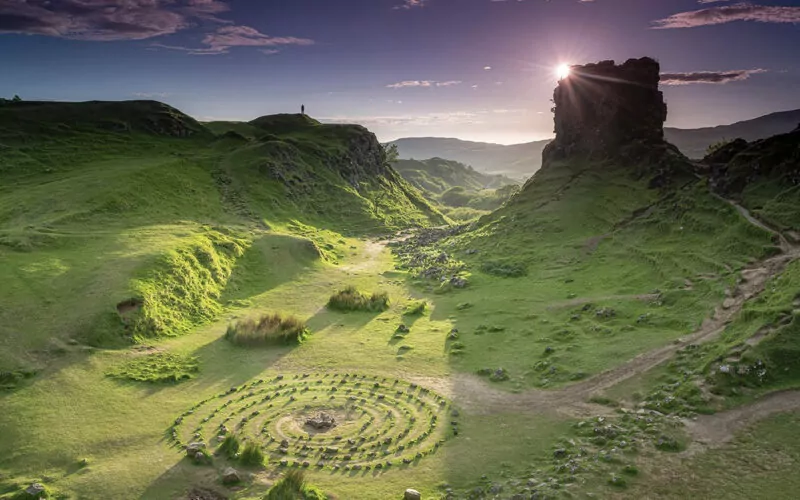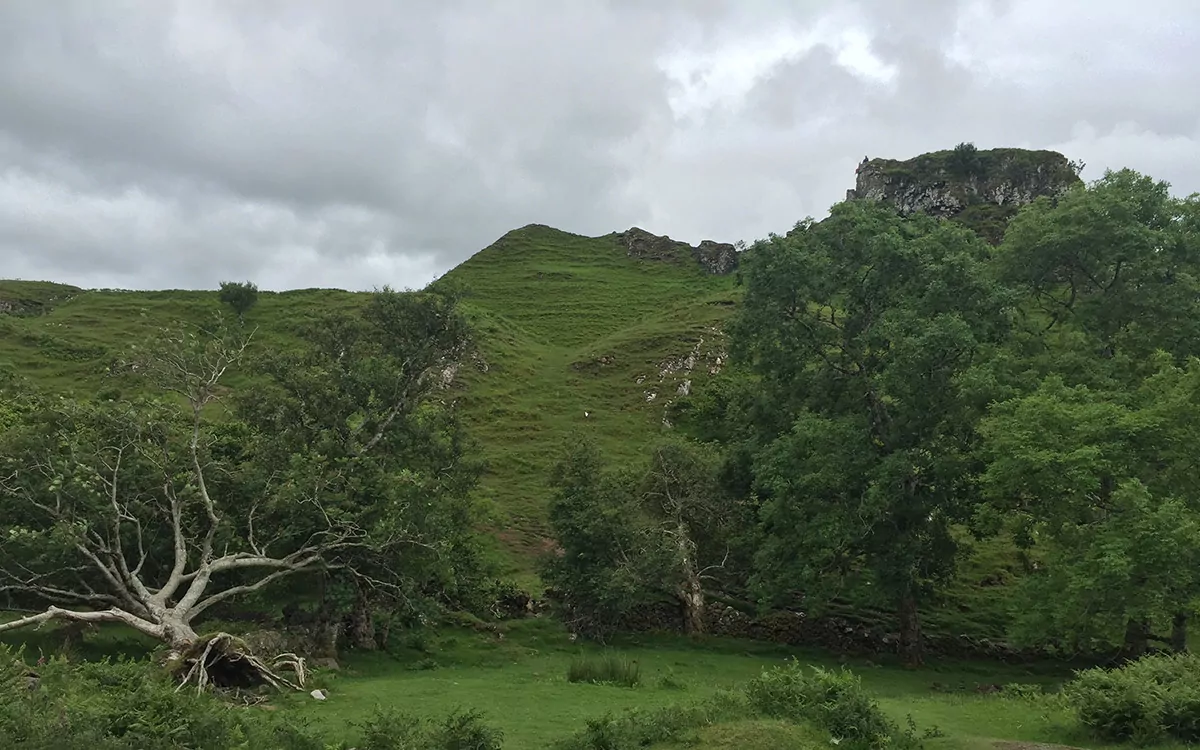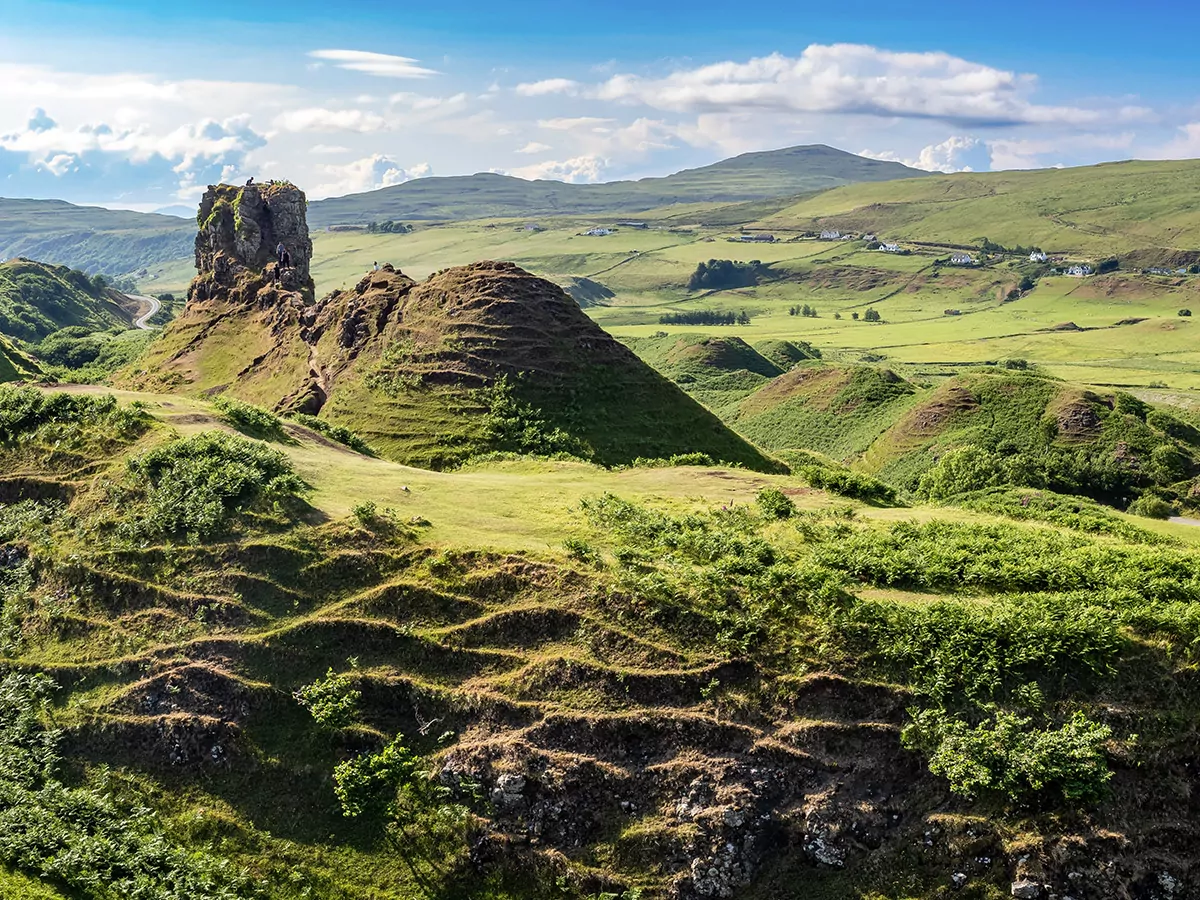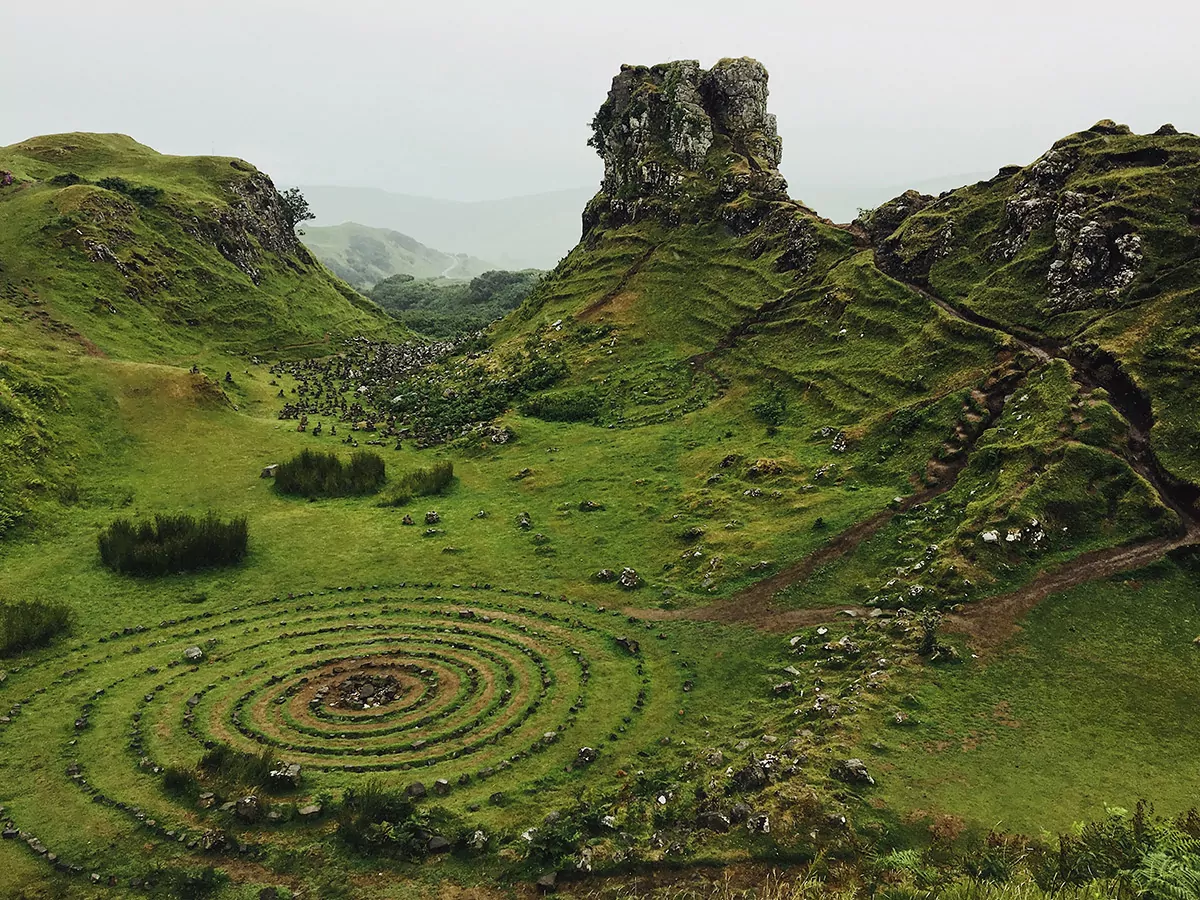A Geek Girl’s Travel Guide to the Mystical Fairy Glen, Isle of Skye

As a self-proclaimed geek girl with a love of whimsical folklore, I’ve always been drawn to places that seem to have leaped straight out of the pages of a fantasy novel. One such place is the Fairy Glen, nestled into the stunning landscape of Isle of Skye, Scotland. And I speak from personal experience when I say this magical haven, with its unique landscape and rich mythology, is the perfect destination for those seeking an immersive experience in the mystical realm.
The Fairy Glen, despite its name, is not known for its fairy sightings but rather for its otherworldly geological formations. As you wander through its rolling green hills and miniature lochs, it’s easy to imagine that you’ve stepped into another world. Located on the western side of Trotternish at Balnacroc above Uig, the enchanting landscape features numerous natural rock formations, including conical mounds resembling small fairy-sized castles, and a spiraling stone circle often associated with magic and folklore.
For centuries, locals have told tales of fairies who supposedly dwell in this lush landscape, and many visitors leave small tokens or offerings in hopes of winning fairy favor. These stories add a layer of enchantment to the location, making it a must-visit spot for every fantasy geek.

The Magic of Fairy Glen
What primarily makes Fairy Glen in Scotland’s Isle of Skye so magical is its landscape. This hidden gem, reminiscent of a fantasy storybook setting, boasts cone-shaped hills, oddly shaped boulders, tranquil ponds, an ancient castle, and mysterious rock formations. Local lore suggests the Glen was named for its supposed fairy inhabitants, and those fortunate enough to encounter these mystical beings are said to receive good luck.
Fairy Glen’s unusual geological structures date back thousands of years to the last Ice Age. Much like the nearby Quiraing, these rock formations are the remnants of an ancient landslip. Over the centuries, glacial movements have sculpted these structures into the distinctive mounds and formations that enchant visitors today. In Scottish folklore, fairies are believed to reside underground and within the small, dome-topped hills and mounds scattered across the Glen.
If you listen closely, it’s said that you may hear the distant music and laughter of a fairy feast happening.
Interestingly, despite the Isle of Skye’s long-standing association with fairy lore — including legends of the Fairy Flag of Dunvegan Castle & Gardens and The Fairy Bridge — no specific legends are tied directly to Fairy Glen. Yet, its name and mystical ambiance continue to spark the imagination, contributing to its reputation as a magical, must-visit spot in Scotland.

Navigating the Fairy Glen
The Fairy Glen is hidden in the Uig Hills in the Trotternish peninsula. Visitors can reach the glen either by car or on foot, with the former being the most convenient option.
If you choose to journey by car, simply veer off the A87 south of the quaint village of Uig, taking the single-track road leading to Sheadar and Balnaknock. This scenic route will guide you directly to the newly established car park. From here, Castle Ewen, one of the Fairy Glen’s most iconic landmarks, is just a short and pleasant walk away.
Because the Fairy Glen is a small place, you’ll likely only need one to two hours to explore fully. The best time to visit is during the earlier part of the day. This is because there are not a lot of parking spaces, so it’s advised to either get there early or later in the day to get a spot. You can pay in coins or with a card for parking, and fortunately, this is the only thing you’ll spend on as Fairy Glen is open free of charge.
The most popular time to visit Fairy Glen is from May to October, with the most popular month being August. However, you can also choose to visit in the winter months when there are fewer visitors. When I visited, I was there at the beginning of July, and I didn’t see anyone at the glen during our visit. We hired a private guide to drive us around for the day, and the Fairy Glen was our last stop, roughly around 4pm local time.
So what do you do when you visit? Climb the stunning geological formations! You’ll get a view of the surrounding landscape, such as the valley, the stone spirals, and the ponds. There are also hiking trails to visit Castle Ewen – be sure to wear sturdy shoes as the way can be slippery depending on the time of year you visit. (And it’s Scotland, so it’s rare for there to be a day with no rain)

Fairies, Folklore, and Fantasy
In Scotland, fairies are also referred to as fays or fees, the wee people, fairy folk, or elves. However, they are said to prefer the name sidh, pronounced “shee.” These fantastical beings are a mysterious and ambiguous force in Scottish folklore. This is because they could be helpful, malicious, or both.
For instance, fairies can steal babies, mislead travelers, or even kill them using an “elf bolt.” But at the same time, these beings may also offer help if needed. They can help you clean your home, guide you on the right path, or maybe save you from a terrible storm.
In a historical sense, the Scottish belief in fairies helped explain the unexplained, such as illnesses. If someone was suddenly overcome with paralysis, skin diseases, or something similar, it was usually believed to be caused by the fairies. But ultimately, fairies are seen as an extension of nature. While they may seem to care less for humans at first, they usually are drawn to our attempts to control what could not be controlled.

Extending Your Adventure on the Isle of Skye
Fairy Glen, or the Isle of Skye in general, has long embraced its magical association. Some tour guides in the area have even included some do’s and don’ts when exploring. These do’s and don’ts tend to refer to what to do if you encounter the fairies. Such rules include not whistling or accepting anything the fairies may try to give you.
If you do accept something, don’t thank them, as it may mean you owe them something in return. It’s also advised to avoid telling the fairies your name. Of course, all these “rules” are in good fun and play into the mythical nature of the local folklore.
There are also sights to see around Fairy Glen, such as the Fairy Glen labyrinth, which is on the way down from Castle Ewen. According to legend, if you follow the labyrinth correctly, you can call on the fairies and make a wish. Aside from the labyrinth, there is also a crop of Rowan trees that grow around Fairy Glen. They are also known as Delight of the Eye, tree of the Goddess, or The Wizard Tree.
Rowan trees also play a part in the local folklore associated with fairies. The wood of a Rowan tree is said to provide protection from these sprightly beings. In Scottish and British folklore, the Rowan tree also protects you from enchantments, witchcraft, and the so-called “Evil Eye.”
A top tip when exploring Fairy Glen and even the areas surrounding it is to bring midge repellent. For Americans not familiar with midges, they’re essentially small flies that we call “no-see-ums.” If there’s no wind during the summer months, it’s best to stay protected with such a repellent as that’s when they tend to be at their peak
Hopefully, our guide has inspired you not just to dream about this mystical place but also to pack your bags and experience its magic firsthand. After all, who knows? You might just be lucky enough to catch a glimpse of the elusive fairies said to dwell within Skye’s stunning landscapes.


Responses